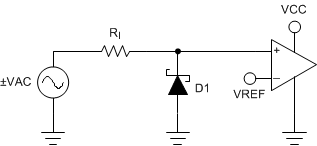SNOAA91 may 2023 TLV1812 , TLV1851 , TLV7011
5 Negative Input Voltages
All the input types have a diode of some type from the input pin to the most negative power supply (Vee, or V-). These diodes can be actual ESD structures, or body diodes or junctions formed by the semiconductor process. The Absolute Maximum voltage for the negative limit is generally -0.2 V to -0.5 V below the negative supply pin.
Applying a negative voltage to any of the pins, not just the input pins, below the negative supply pin can forward-bias these internal parasitic junctions, and cause currents to flow where current is not designed to flow.
These currents can cause malfunction of the device, such as reversals, high supply currents or false outputs, and possibly even cause another channel within the device to malfunction.
In cases where a negative input voltage cannot be avoided, a current limiting resistor in series with the input can limit the current to a safe level, as shown in Figure 5-1. The diode must be a Schottky type for lowest forward voltage. TI always recommends using external clamping components and not to rely on the device internal clamps or ESD diodes.
 Figure 5-1 Recommended Clamp For Negative
Voltages
Figure 5-1 Recommended Clamp For Negative
VoltagesThe resistor must be calculated to limit the current to 1 mA or less at the highest expected voltage. A rule of thumb is 1 kΩ per volt of expected overvoltage. This resistance can be part of the divider or other resistive input network.
For more information on protecting the inputs, please see section 2.9 of the "Application Design Guidelines for LM339, LM393, TL331 Family Comparators" application note.